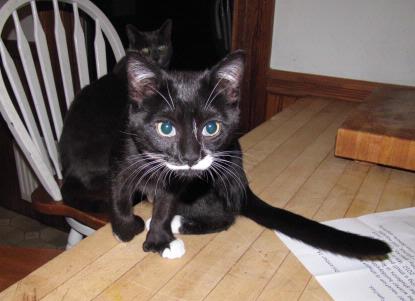In our house these days little cat feet don’t bring in the fog as Carl Sandburg suggested. They jump around scaring the other much more dignified cat. They incite games of chase with the indigent boarders. We have taken on a kitten because life had become a silent idyll and I had become antsy. Now we have a miniature gladiator ring about the center of the house around which the youngest human and feline spin furiously, until one gets scratched. It’s always the deserving one who gets scratched.
We call her zipper because, ahem, she zips. This was not my idea, but it’s better than all the Pokemon names that were suggested. She is a bit of a pill in many ways. To pick a single example, unlike every other cat I’ve had, I can’t seem to teach her not to get on the counter.
Zipper has extra claws. The better to scratch you with my dear. She has two extra on each forefoot and an extra dew claw on each hind leg. These armaments make her a bit more dangerous than the average cat. She also climbs: a slippery banister, my leg, the inside of the shower curtain, the boss’ jumpers, pretty much anything that strikes her fancy.

Preaxial polydactyly, the state of having extra digits on the thumb or big toe side of a limb, is rare in cats worldwide. Oddly it is common in certain places: Key West, Maine, Boston, the northwestern U.S. and parts of Wales. It has been suggested by somewhat unreliable sources (the Straight Dope) that because these cats make great climbers and mousers they were favored on ships, so they are still around old port cities. What is known is that Ernest Hemingway received a polydactyl cat named Snowball and took a fancy to him. There are now 50 or so polydactyl cats hanging around the Hemingway museum. This despite the fact that I wouldn’t bet on a Snowball’s chance in Key West.
About four years ago some pointy-heads got together and tested whether a common cause of polydactyly in humans also leads to the extra claws in cats (Lettice et al 2008 Human Molecular Genetics). It turns out it does, but what’s more fascinating to me is why it does. The mutation causes a protein to appear a little early in limb formation. The protein is called Shh, or Sonic Hedgehog. That’s right; it’s named after the Sega Genesis character. It was first discovered in fruit flies. Fruit fly scientists (or at least scientists who study fruit flies) are some of the few scientists with a sense of humor. Sonic Hedgehog is responsible for forming lots of body parts, but when turned on at the wrong time it can cause duplications. It just so happens that this duplication is cute.
In any case, I now have an extra clawed cat and I have Sonic the Hedgehog to blame for it.


